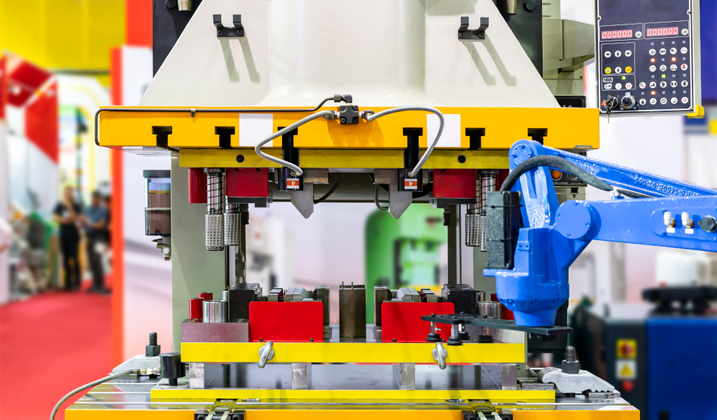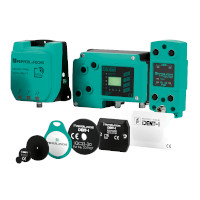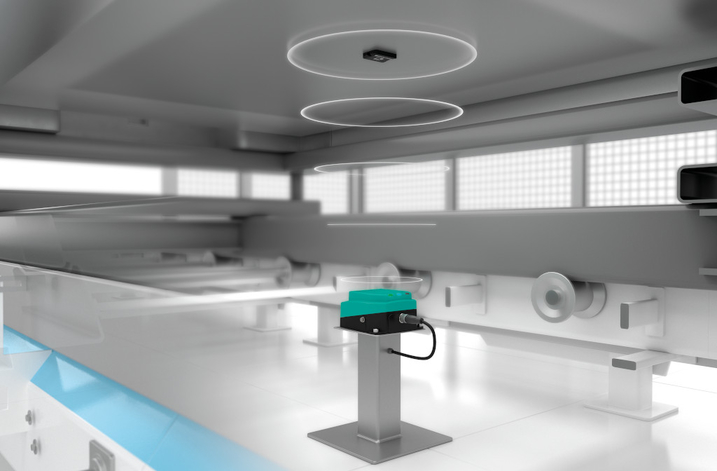RFID Systems in Industrial Metal Stamping
RFID Systems Ensure That Forming Processes Run at Maximum Efficiency

The Application
Ensuring the correct die is pulled for a given job is perhaps the most important error-proofing step in a stamping process. And why? A mismatched die can crash on the first stroke, saddling a company with both the tangible costs of tool and machine damage as well as the opportunity cost of unplanned downtime, often extending over days, sometimes weeks.
The process of identifying the die set and loading the information into the press control software has traditionally been manual and therefore prone to human error. Simple, painted/printed serial numbers are probably the most common die identifier. But over time, markings wear off and become unrecognizable, increasing the risk of errors. A smeared or worn ID code might read “KY537-2” or “KV537-2”—it all depends on the worker’s visual interpretation. Even if a painted-on serial number is read correctly, an operator may mistakenly “fat finger” the wrong characters when entering it.
An improvement to human die identification is barcode scanning. When connected to a press control system, barcode systems eliminate human error by automatically identifying the die through electronic scanning. There are many different optic-based reading technologies, from using adhesive labels to directly peening, printing or laser etching Data Matrix codes on the die block. However, the self-adhesive barcodes often lack the durability required in the pressroom, while the more expensive, robust variants are mechanically durable but unpredictable in terms of readability. Especially when contaminants accumulate or at longer scanner-to-code distances.
None of the above options provide the security or readability that an RFID solution offers.
The Goal
The benefits of RFID don’t just start at the press. They start earlier, in the die storage area. Die warehouse layouts range from loosely organized lots scattered on the floor to neatly coordinated shelving systems. It all depends on the company’s needs, size, and budget. At any given time, there may be “dozens” to “hundreds” of dies on hand, some of which are used weekly, while others are only needed once every few years.
The easier it is to locate a die, the faster the press can begin stamping parts and generating revenue. Locating a “tagged” die is as simple as viewing the pick location on your computer or phone dashboard, verifying the ID with a handheld reader and transferring the die to the press. Without RFID verification, a worker may accidentally pick a die from the wrong rack. Or they may select the correct location, but it’s all for naught if the wrong die was stored there after a previous job. An ID scan triggers an immediate notification of a misplacement.
If the incorrect die makes it to the press, a worker can catch the error before start-up. However, even if luck and an attentive operator prevented a crash, the misstep is not without cost. The process of uninstalling the wrong die wastes valuable hours that could have been spent producing parts.
With tagged dies and a confirming scan from an RFID reader, incorrect die selection or misplacement is prevented.
The Solution

RFID tags and readers
There are a variety of RFID products that overcome the shortcomings of human and optical identification.
An RFID system consists of a scanner, an ID tag, and a controller. Not only can the electronic tags be read, but job information can also be written to the tag. Therefore, data such as die usage, operator history, and die-specific setup instructions are instantly updatable and available. In addition, many tags can be embedded flush in metal, protecting them from damage during storage and retrieval.
An RFID’s die set confirmation can be done with 100 % noncontact certainty. Unlike optical readers, alignment is much more forgiving. The antenna used to read or update tag information covers a large area. This wide detection field is particularly helpful on large presses where the upper and lower dies are stored separately. If the upper and lower dies are not properly paired during installation, a major die crash is inevitable. A single UHF system can simultaneously read the tags mounted on the upper and lower dies before start-up to ensure they match.
Technical Features of RFID Tags & Readers
- Operating frequency 13.56 MHz
- Conformance with ISO 15693
- Degree of protection (IP67/68)
- ID tags can be embedded flush in metal and have read distances up to 13 feet
- Mounting holes for simple installation of tags
- Read/write heads have dual LEDs for function display
- UHF systems enable multi-tag reading

The Benefits
The benefits of RFID go far beyond simple but important initial error proofing. They are truly only limited by pressroom requirements and engineering ingenuity. This is where IIoT comes into play.
With the power of die identification, it is easy to track usage hours. Instead of relying on a human to determine the condition of a die, preventative maintenance can be triggered automatically. No more worries of producing parts of decreasing quality due to tooling that’s unknowingly slipped past its refurbishing date.
Combining RFID scanners with part sensors provides a high-resolution view of actual die usage. Many RFID systems easily connect to a company’s MES/ERP/SCADA software via standard IIoT communication protocols such as MQTT, OPC UA, or REST API. This makes the move from traditional human and spreadsheet-based performance analysis to real-time, error-free status updates easier than ever. The number of parts produced, hours remaining until required maintenance, die location, availability status, and monthly die hits—all the data you consider important, can be visible to anyone, anytime, anywhere.
At a Glance
- Automatic die identification eliminates human error
- Implementing RFID in the pressroom is a gateway to efficiency-improving IIoT initiatives
- Die crashes due to improper die selection and placement are eliminated
- Important job information, such as die usage, can be written to RFID tags










 +1 330 425-3555
+1 330 425-3555